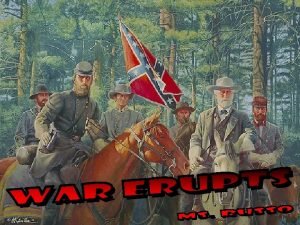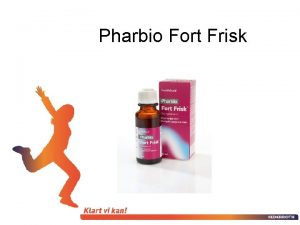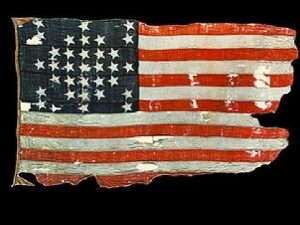PreAD 43 Fawdon Hill Fort Fawdon Hill sits





















- Slides: 21

(Pre-AD 43) Fawdon Hill Fort Fawdon Hill sits within the Breamish and Ingram Valley in Northumberland. In the hills and valleys you can see traces of forts and burial mounds from the Neolithic, Bronze and Iron Ages. If you explore this area you will also see signs of ancient methods of farming that have left their mark on the landscape. Hill forts were built up mounds of earth with a settlement on the top. You can find evidence of hill forts all over Europe. At the Fawdon Hill Fort site, you can see marks in the earth where the circular huts would have stood. There is also evidence of a cairn (a pile of rocks marking a burial ground) and traces in the earth of some ramparts which were the walls around the settlement. Fawdon Hill Fort [© 50 ft Long Horse 2015] Why did people build walls around their settlements?

(AD 127) Segedunum Roman Fort In AD 122, the Roman Emperor Hadrian ordered a wall to be built from east to west across England from the River Tyne to the Solway Firth. In AD 127 the wall was extended further east to Wallsend. The wall stretched 73 miles and was built to defend the Roman Empire from the barbarians in the north. Before Hadrian’s Wall, Emperor Antoninus Pius built the Antonine Wall further north from stone and turf. Segedunum Roman Fort sits at the very end of the wall in Wallsend. Six hundred Roman soldiers from modern Belgium and northern France lived there. Hadrian’s Wall today is a World Heritage Site and you can visit the forts along its whole length. Segedunum includes a reconstructed Roman bath house. Reconstruction of Roman wall at Segedunum site, Wallsend. [© 50 ft Long Horse 2015] Why didn’t the Romans want to invade further north?

(c. AD 200) Pons Aelius Rebuilt The Norman Castle Keep in Newcastle now stands where a Roman fort and settlement called Pons Aelius once was. Artefacts from the site, including alter stones, are in the Great North Museum, Hancock collections. ‘Pons’ means bridge and ‘Aelius’ comes from the family name of the Emperor Hadrian. The fort dates from AD 122 but was rebuilt in stone during the reign of Emperor Septimius Serverus (AD 193 -211). A Roman bridge connected Pons Aelius to the central Cade Road, an important route to York. It was the first major bridge to cross the River Tyne and the only Roman bridge outside Rome to be named after an emperor, suggesting it was very important. In 1872, remains of the bridge were found where the Swing Bridge now stands. Castle Keep, Newcastle city centre. [© 50 ft Long Horse 2015] What technology did the Romans use to build bridges?

(AD 370) Huntcliff Signalling Station Roman signalling stations were built along the North East coast to look for invaders and warn people in advance. The stations sat on high cliffs with steep drops to the sea. They were perfect points for seeing a long way out. Beacons at the stations would be lit when invaders were spotted so people could prepare for attack. The signalling station at Huntcliff is in the Saltburn area. The walls of the station were very thick and the corners were rounded to make it stronger. Remains found there include coins, parts of cooking pots, a leather sandal, cloth and the remains of around 14 humans. One of the skulls has a deep cut from a weapon suggesting there was a violent raid at the site. Detail from an outdoor local information plaque, Saltburn-by-the-Sea. [© not required] Who was invading Britain from across the sea?

(From AD 420) The Birth of Northumberland Roman soldiers left Hadrian’s Wall around AD 420 leaving the area very exposed. Coel Hen (meaning ‘Coel the Old’ or perhaps ‘Old King Cole’) was a leader in Roman Britain in the Hen Ogledd (‘Old North’). This kingdom was probably ruled from modern day Bamburgh. When the Angles invaded from Germany, two kingdoms were created in the north called Bernicia and Deira. Bernicia covered the area of modern Northumberland County Durham. Deira ran from the River Humber to the River Tees including the Derwent Valley area. It stretched from the east coast to the outskirts of York. The kingdoms were unified at the beginning of the AD 600 s to form Northumbria, named after the River Humber. Ancient map of Northumberland showing the reach of the kingdom. [© The British Library Board 2015] What do you think everyday life was like in Hen Ogledd?

(AD 547) Bamburgh Castle Ida the Flame Bearer, first Anglo-Saxon chief of the kingdom of Bernicia, lay the timber foundations for the original Bamburgh Castle. Ida was the most powerful leader in northern Angle Land (modern England) and Bamburgh was the capital of his kingdom. When Ida died, his bloodthirsty grandson Aethelfrith the Destroyer became king. Bamburgh Castle sits on a high cliff so was naturally well protected against attack. In Roman times, there was a signalling station here because the views across the sea were so good. The castle continued to be the home of the kings of Northumbria over a period of rebellion, unrest and royal succession. Bamburgh Castle was lovingly restored by Lord Armstrong, a famous Victorian industrial inventor from the North East. View of Bamburgh Castle. [© 50 ft Long Horse 2015] What is the Bamburgh Beast?

(AD 651) Tynemouth Priory In the AD 600 s, the kingdoms of Bernicia and Deira in the north were at war with each other. In AD 651, King Oswin of Bernicia was murdered by Deira soldiers. Oswin’s body was brought to Tynemouth for burial. Because Oswin was buried there, Tynemouth became an area of pilgrimage and a priory was built. Three kings were buried at the priory including Malcolm III, King of Scotland, who died at the battle of Alnwick in AD 1093. In the AD 800 s, the priory was plundered and destroyed by the Danes during their invasions in the north. During the attack, the nuns of St. Hilda (who were at Tynemouth for safety) were massacred. During Norman rule, the priory became the fortress of Earl Tostig Godwinson, the brother of Harold II. Tynemouth Priory ruins, Tynemouth. [© 50 ft Long Horse 2015] Why was Malcolm III, King of Scotland, buried in Tynemouth?

(AD 731) St. Bede and Jarrow Monastery Bede was born in Jarrow, South Shields, in AD 673. At the age of 19 he became a deacon at St. Paul’s Monastery in Jarrow and at the age of 30 he became a priest. He was also a great teacher, writer and scientist. In AD 731, Bede wrote the Ecclesiastical History of the English People – this told the story of the history of England the arrival of Christianity. This was the first writing to use the term ‘Anno Domini’ (or ‘AD’) to refer to the period of history after Christ. As an early scientist, Bede wrote about the Earth being a sphere and the influence of the moon on the tides. He calculated when identical years would repeat to set the date of Easter. St. Paul’s Monastery, Jarrow. [© 50 ft Long Horse 2015] What were Bede’s writing materials made of?

(AD 875) Cuthbert’s Journey from Lindisfarne Cuthbert lived a simple life as a preacher on Lindisfarne. He was said to have miraculous healing powers and was treated as a saint when he died. The Lindisfarne Gospels are thought to have been written by Eadfrith after Cuthbert’s death in his honour. Eleven years after Cuthbert’s death his body was incorrupt (meaning it still looked like it had when he was alive). This, combined with his status as a saint, led to Lindisfarne becoming a place of holy pilgrimage. In AD 875, the monks moved Cuthbert’s body and other precious artefacts from Lindisfarne to protect them from Viking raids. St. Mary and St. Cuthbert’s Church at Chester le Street was built to house and protect Cuthbert’s body. Interior detail of St. Mary and St. Cuthbert’s Church, Chester le Street. [© Copyright Alexander P Kapp and licensed for reuse under this Creative Commons Licence] Where is St. Cuthbert’s body now?

(AD 973) Washington Old Hall is the medieval manor house and the family home of the Washington family, made famous through connections to George Washington who became the first president of the United States. English styles of architecture, such as halls and manors, were popular in America from the 1600 s. The Old Hall is first mentioned in a charter in AD 973 when it was a wooden building. The stone hall was built in 1183 at which time it was owned by the Washington family. Large parts have been rebuilt and the main buildings that stand today mostly date from the 1600 s. Washington is a very old Anglo-Saxon place name and has been spelt in different ways – Wessynton, Whessingtun and Wassington. Washington Old Hall, Washington. [© 50 ft Long Horse 2015] What role did George Washington have in the American War of Independence?

(AD 1095) Tynemouth Castle By 1095, a wooden castle had been built on the site on the headland in Tynemouth which included Tynemouth Priory. Robert de Mowbray, Earl of Northumberland, used the castle as a safe place when he was rebelling against King William II. He was later caught and sent to prison for treason. In 1312, King Edward II used the castle for refuge. This story is told through the famous play Edward II by Christopher Marlowe written in 1594. More recently, the castle site has been used as a light house, an army barracks and a coastal defence area during World War Two. The moated walls and towers, and the gatehouse of the castle are within the same site as the ruins of the priory. Tynemouth Castle, Tynemouth. [© 50 ft Long Horse 2015] Why was Tynemouth Castle such a good place of refuge?

(1145) The Church of the Holy Cross in Wallsend was built by the monks from Jarrow Priory in 1145. In the same way as many other buildings along the length of Hadrian’s Wall, it was constructed from stones taken from the wall. It is one of the oldest medieval churches in the UK. The church is the setting for the ‘Wallsend Witches’ legend. Someone from the Delaval family found three women in the church around a cauldron one night. He managed to catch one of the woman, and she was trialled and found guilty of witchcraft. In the legend she was sentenced to death by burning on Seaton Sands and ‘rose up from the flames’. Other witch stories from the region include the ‘Berwick Witches’ and the ‘Newcastle Witches’. The Church of the Holy Cross, Wallsend. [© 50 ft Long Horse 2015] What other buildings were built from stones from Hadrian’s Wall?

(1239) Blackfriars Friary Five orders of friars established within the city walls of Newcastle in the 1200 s. Blackfriars were part of the Dominican order. Their site in Newcastle was set up by a wealthy merchant, Sir Peter Scott. Friars were different from monks. They tended to be housed in more urban areas as they begged for money. The Blackfriars’ friary in Newcastle included two gardens and four small farm areas; these provided them with some income. In the reign of King Henry VIII, the buildings of the five friaries and a nunnery in Newcastle were either given to rich merchants or demolished. The convent at Blackfriars was given to the Mayor of Newcastle who rented it out to the craft guilds. The guilds included tailors who made clothes and cordwainers who made rope. Blackfriars courtyard, Newcastle City Centre. [© 50 ft Long Horse 2015] What did the friars wear?

(1390 s) Hylton Castle The earliest castle in Hylton dated back to around AD 1072 and was made of wood. In the late 1300 s, Sir William Hylton built a four-storey fortified manor house in the style of a castle. Over the years the castle has been altered and decorated reflecting the wealth of the Hylton family, who lived in the castle until 1746. The chapel on the site dates from 1157. One of the really interesting features of the castle are the 20 shields of arms decorating the outside. They show all the political connections the Hylton family had throughout the history of the castle. They include the banner of the king, and the arms of nobles and knights from Northumberland. Hylton Castle ruins, Sunderland. [© 50 ft Long Horse 2015] What were coats of arms and why did families have them?

(1441) The Manor of Burradon In 1441, John Orde bought the Manor of Burradon when it was in a very run down state. It had been attacked by the Scots and the land there had poor quality soil. Burradon Tower, which still stands on the site, was built around 1553 by John’s nephew, Bertram Anderson. In 1569, the property was bought by the Ogle family who improved and extended it. Burradon Tower is sometimes known locally as the Pele Tower houses were not large enough to be called castles, but were still fortified. During this period, Northumberland was under constant attack from the Scots and local family arguments so it was a good idea to fortify your houses. Tower houses often had a tunnel running underneath to help people escape from attacks. Burradon Tower ruins, Burradon. [© 50 ft Long Horse 2015] Why was Northumberland under attack from the Scots?

(1505) Trinity House, Newcastle Trinity House is run by a corporation that was established as a guild in 1505 by Newcastle seafarers. It is in the Broad Chare area of Newcastle Quayside. The corporation was responsible for making sure the River Tyne was safe and could be easily navigated by ships. Over time they took on more responsibilities, such as providing licences for mariners and maintaining the ‘sea lanes’ between Berwick and Whitby. They also did charity work including setting up a school at Trinity House and building alms houses. The corporation of the Newcastle Upon Tyne Trinity House still exists today to support safety on the River Tyne, offer help for elderly mariners and provide access to the extensive archive across its 500 -year history. Trinity House, Newcastle Quayside. [© 50 ft Long Horse 2015] Why was the River Tyne such an important trade route for ships?

(1625) Clifford's Fort and the Old Low Light The Old Low Light and Old High Light were established in Tynemouth by Trinity House in the 1500 s. They provided the vital role of helping ships navigate into the mouth of the River Tyne. In 1625, the walls of Clifford’s Fort were built around these lights causing ongoing disputes between Trinity House and the governor of the fort. Clifford’s Fort was built to defend the River Tyne during the English Civil War. It was constructed from gabions (big metal cages filled with rocks). In the 1670 s, the fort was strengthened so it could act as a defence during the Dutch Wars; it held up to 40 mounted guns. The fort continued to play an important defence role during the Napoleonic Wars. The Old Low Light overlooking the mouth of the Tyne. [Courtesy: http: //oldlowlight. co. uk/] How was the North East involved in the English Civil War?

(1728) Seaton Delaval Hall was designed by architect John Vanbrugh for Admiral George Delaval and built in 1728. The Delaval family had owned the land since the AD 1000 s and knocked down an existing mansion to build the new hall. The architecture of the hall was extremely grand in a very fashionable English Baroque style. Unfortunately, George Delaval never saw the completed hall because in 1723 he fell off his horse at the estate and died. In the 1700 s, the Delaval family became known for their large parties at the hall, practical jokes and gambling. They were also a very industrious family. They were involved in coal mining, salt production and glass making as well as creating Seaton Sluice to help ships coming into the harbour. Seaton Delaval Hall grounds, Seaton Sluice. [© 50 ft Long Horse 2015] What other buildings were designed by architect John Vanbrugh?

(1882) Tynemouth Station is one of the oldest railway stations on the Tyne and Wear network. The station was built by the North Eastern Railway using designs by architect William Bell. It is a great example of the care and pride given to the railways in the Victorian period with beautiful cast iron work, wide platforms and space for plants to decorate the station. It is still a functioning station and is Grade II listed. The North East played an important role in the history of the railways as it was the birthplace and workshop of George Stephenson. The railways developed from the colliery waggon ways in the North East to the Stockton and Darlington Railway, the world’s first public railway to use steam locomotives. Tynemouth Station, Tynemouth. [© 50 ft Long Horse 2015] Where did George Stephenson build the locomotive and why was it so important?

(1910) Spanish City and Whitley Bay Pleasure Gardens opened in 1910 as an area of entertainment. It included shops, a roof garden, the Empress Theatre, a restaurant, tearoom and later the Empress Ballroom Rotunda and a permanent funfair. The dome also housed an amusement arcade. The funfair was a very popular local attraction, like a mini Blackpool Pleasure Beach. Mark Knopfler, Dire Straits singer-songwriter, grew up near Spanish City and wrote about it in a song called Tunnel of Love in 1980. This became a theme tune for Spanish City and was played every day when the site was opening. Spanish City in the 1950 s, Whitley Bay. [© Ken Hutchinson] In 2014, North Tyneside Council unveiled plans to regenerate Spanish City and restore some of the buildings. Why was it called Spanish City?

(2002) National Renewable Energy Centre In 2002, as part of the Strategy for Success Programme, One North East (a regional development agency) created the New and Renewable Energy Centre in Blyth. In 2010 the company changed its name to the National Renewable Energy Centre (Narec). It specialised in renewable energies and low carbon technologies including offshore wind turbines, marine renewable energy and solar electricity through photovoltaics. Narec is now Catapult Offshore Renewable Energy, one of seven Catapult centres in the UK that support businesses, scientists and engineers to work together. The North East centre specialises in leading technological advances in renewable energy. The North East coastline is ideal for offshore wind turbines and marine renewable energy. Interior manufacturing space at Narec. [© Na. Rec 2015] Which North East engineer invented turbines and how do they work?
 Il y a fort fort longtemps
Il y a fort fort longtemps Veux-tu briser du péché le pouvoir pdf
Veux-tu briser du péché le pouvoir pdf Yergason test
Yergason test The king sits in dumferling toune accent marks
The king sits in dumferling toune accent marks A box sits in a pickup truck on a frictionless
A box sits in a pickup truck on a frictionless Majestic sweetness
Majestic sweetness Example of projectile motion
Example of projectile motion Surreysits
Surreysits A coin sits on a turntable
A coin sits on a turntable I wish that i were old enough to vote dgp
I wish that i were old enough to vote dgp Tissie
Tissie A brick sits on a table until you push it
A brick sits on a table until you push it Striker chemistry lab equipment
Striker chemistry lab equipment The girl who sits behind rafael is a better student than i
The girl who sits behind rafael is a better student than i The british parliament sits in
The british parliament sits in Mms st andrew
Mms st andrew Conservation of momentum and energy
Conservation of momentum and energy Horton hatches the egg quotes
Horton hatches the egg quotes A physics textbook swings back and forth as a pendulum
A physics textbook swings back and forth as a pendulum Science equipment
Science equipment Sits on the iron ring to provide a place to stand a beaker
Sits on the iron ring to provide a place to stand a beaker Fred throws a baseball 42 m/s horizontally
Fred throws a baseball 42 m/s horizontally








































